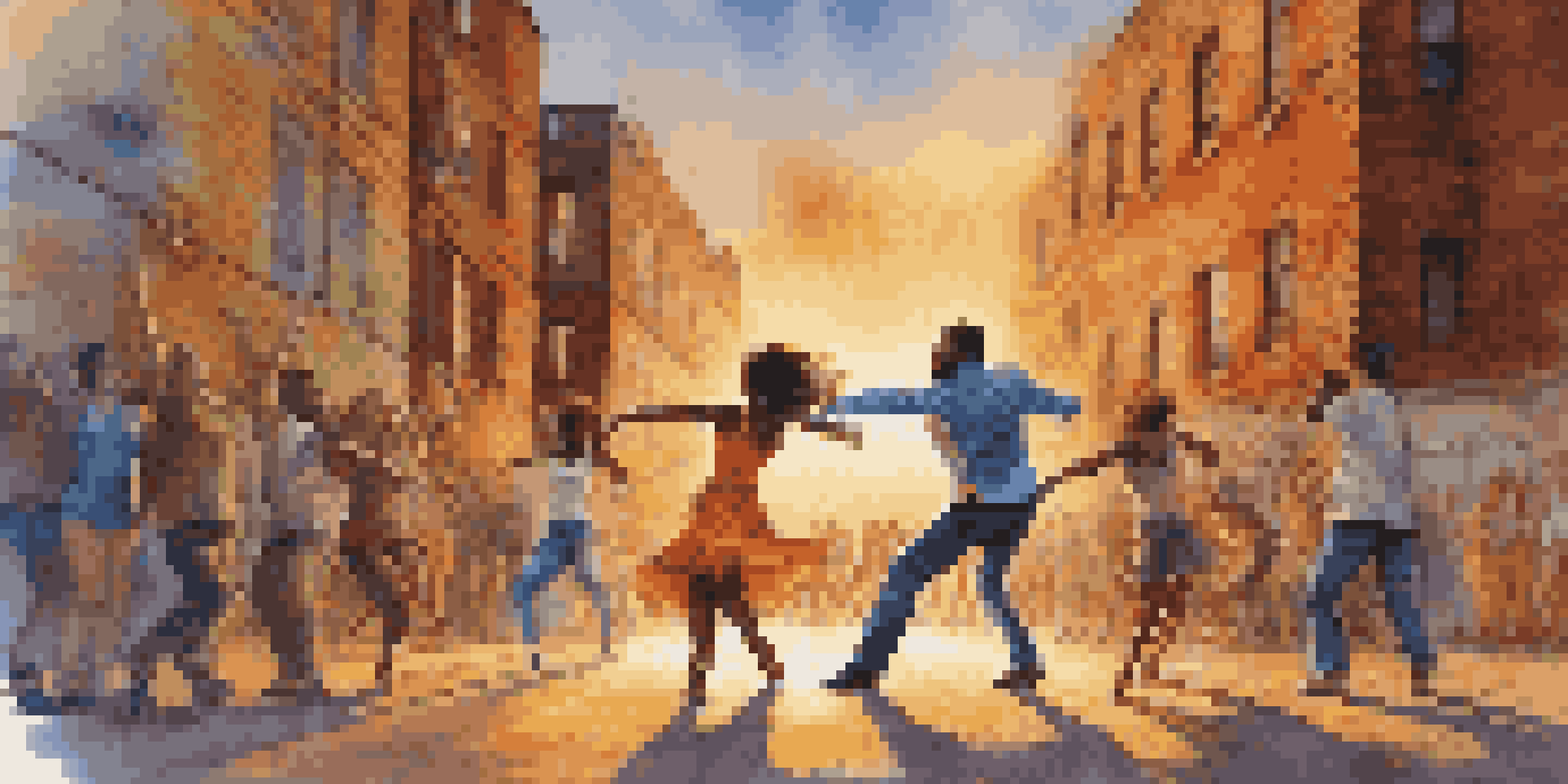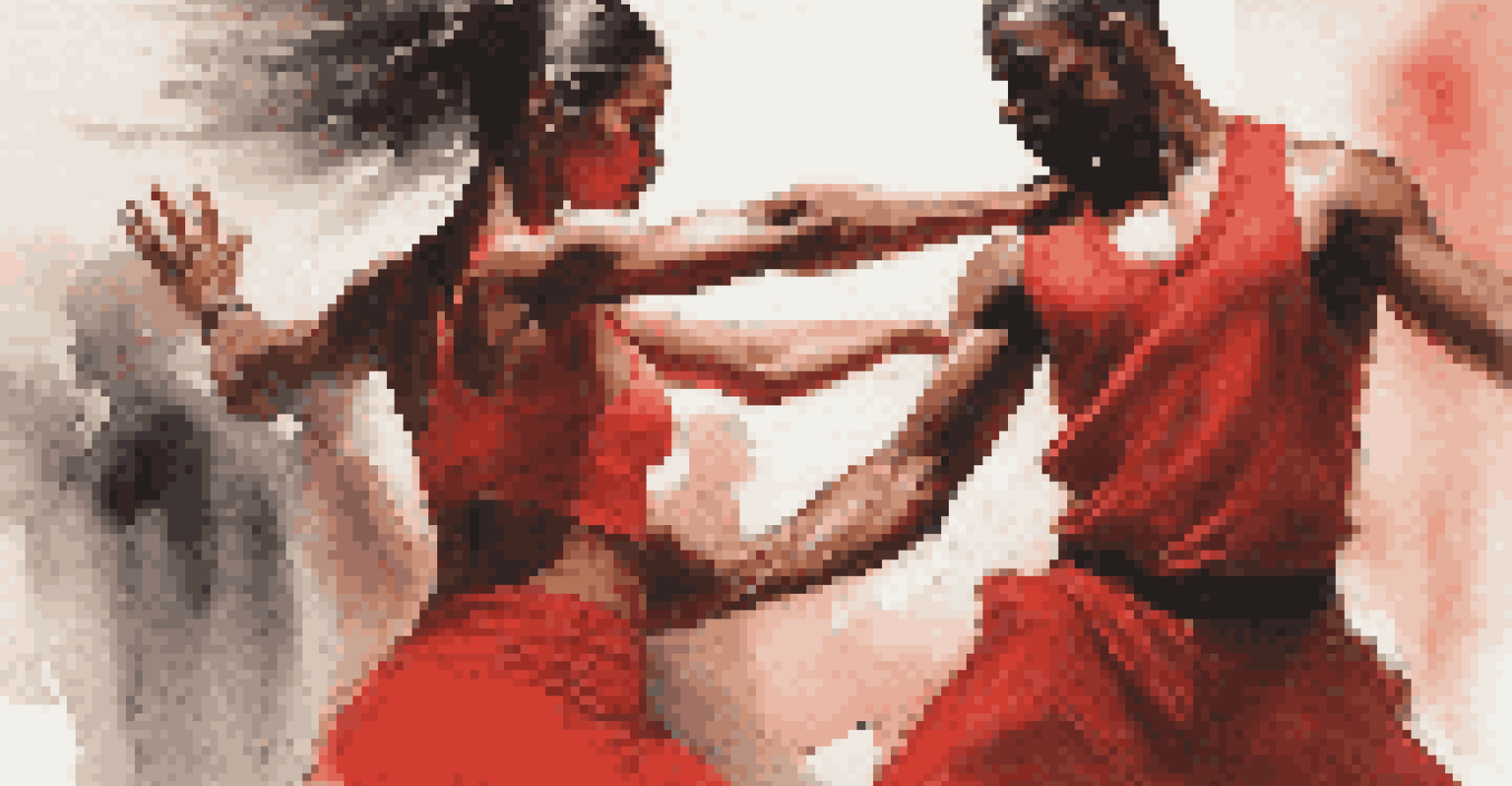Dance Battles in Film: Conflict and Resolution Through Movement

The Origins of Dance Battles in Cinematic History
Dance battles in film have deep roots, often reflecting cultural conflicts and artistic expression. From classic movies to modern blockbusters, these energetic showdowns serve as a powerful narrative device. They often highlight the struggle between opposing characters, creating a visual representation of their internal and external conflicts.
Dance is the hidden language of the soul.
One of the earliest examples can be seen in films like 'West Side Story,' where dance becomes a means of territorial assertion. The choreography not only entertains but also communicates the tension between rival gangs. This sets the stage for future films where dance battles become a staple in storytelling, illustrating the complexities of competition and rivalry.
As film evolved, so did the portrayal of dance battles, blending various styles and cultures. Movies like 'Step Up' and 'You Got Served' showcase how dance can transcend words, offering a universal language for conflict resolution. These battles are not just about winning; they also convey messages about unity, passion, and the power of self-expression.
The Role of Conflict in Dance Battles
At the heart of every dance battle lies conflict, whether it’s personal, social, or artistic. This tension fuels the narrative, drawing audiences into the characters' struggles. It’s fascinating how two opposing forces can use movement to express their emotions and motivations, turning physicality into a metaphor for their battles.

For instance, in 'Step Up Revolution,' the dance battles symbolize the fight against gentrification. The characters channel their frustrations and hopes into their performances, transforming a mere competition into a larger commentary on community and identity. This adds layers to the conflict, making it relatable to audiences who may have faced similar challenges.
Dance Battles Reflect Cultural Conflict
Dance battles in film serve as a powerful narrative device, illustrating the complexities of competition and cultural struggles.
Moreover, the choreography itself often reflects the nature of the conflict. Sharp, aggressive movements can signify anger or rivalry, while fluid, harmonious sequences may represent resolution or unity. This dynamic interplay between conflict and movement creates a captivating experience, keeping viewers on the edge of their seats.
Choreography: The Language of Movement
Choreography in dance battles is not just about impressive moves; it's a language of its own. Each step, spin, and freeze can convey emotions and intentions, making it essential for storytelling. The intricacies of choreography communicate the stakes of the battle, allowing dancers to express complex feelings without uttering a single word.
The only way to make sense out of change is to plunge into it, move with it, and join the dance.
In films like 'Street Dance,' the choreography evolves as the characters grow, reflecting their personal journeys. As they face challenges, their dance styles adapt, showcasing their resilience and determination. This evolution in movement further emphasizes the significance of dance as a form of conflict resolution.
Additionally, the use of different dance styles can symbolize various aspects of conflict. For instance, hip-hop may represent rebellion, while ballet could signify grace under pressure. This blend of styles enriches the narrative, allowing filmmakers to craft a more nuanced portrayal of conflict and its resolution through dance.
Cultural Significance of Dance Battles
Dance battles are deeply rooted in cultural expressions and traditions. They often serve as a platform for showcasing diverse dance styles, highlighting the rich tapestry of cultural influences. This cultural significance not only entertains but also educates audiences about different communities and their histories.
For instance, films that incorporate street dance styles, such as krumping or breaking, often reflect the socio-economic struggles of their origins. By showcasing these styles in a competitive setting, filmmakers bring attention to the cultural contexts from which they arise. This not only honors these traditions but also invites viewers to appreciate their artistry and significance.
Choreography as a Storytelling Tool
The intricacies of choreography in dance battles convey emotions and motivations, making it an essential element of storytelling.
Moreover, dance battles promote inclusivity and unity among diverse groups. They create a space where individuals from different backgrounds can come together to celebrate their differences through art. This message resonates deeply in today's globalized world, where understanding and collaboration are essential.
The Impact of Music on Dance Battles
Music plays a pivotal role in dance battles, setting the tone and enhancing the emotional impact of the performance. The right track can elevate a dance battle from a simple competition to an electrifying spectacle. It's fascinating how the rhythm and lyrics can influence the dancers' movements and the overall energy of the scene.
In films like 'Flashdance,' the iconic soundtrack is almost a character in its own right, driving the narrative forward. The music not only complements the choreography but also adds depth to the characters’ motivations, making their struggles and triumphs more relatable. This synergy between music and dance creates a powerful emotional experience for the audience.
Furthermore, the choice of music can reflect the cultural background of the dancers, adding another layer of meaning to the performance. Whether it's hip-hop, pop, or classical, each genre brings its own flair and storytelling potential. This connection between music and dance underscores the importance of sound in shaping the narrative of dance battles in film.
Resolution Through Dance: Finding Common Ground
Ultimately, dance battles often culminate in resolution, showcasing the power of movement to bridge divides. As characters face off, their interactions can lead to understanding and reconciliation, demonstrating that conflict can be a catalyst for growth. This transformation is beautifully illustrated through the choreography, which evolves from aggressive competition to collaborative expression.
In many films, the conclusion of a dance battle signifies not just the end of rivalry but the beginning of friendship or mutual respect. For example, in 'Battle of the Year,' the characters learn to work together towards a common goal, using their individual strengths to unite as a team. This narrative arc reinforces the idea that conflict, when approached with creativity and passion, can lead to positive outcomes.
Music Enhances Dance Battle Impact
The right music elevates dance battles, influencing the dancers' movements and adding depth to the characters’ narratives.
Moreover, the final dance sequences often embody themes of unity and celebration. The dancers come together, merging their styles and strengths, creating a visual representation of harmony. This resolution through dance not only entertains but also inspires audiences to see the potential for understanding in their own conflicts.
The Future of Dance Battles in Film
As the film industry continues to evolve, so too does the portrayal of dance battles. With advancements in technology and changes in audience preferences, filmmakers are exploring innovative ways to showcase these vibrant performances. From virtual reality experiences to immersive storytelling, the future holds exciting possibilities for dance battles in film.
Moreover, as global cultures continue to intersect, we can expect to see an even richer tapestry of dance styles represented on screen. Filmmakers are increasingly drawing from diverse influences, creating a more inclusive and dynamic portrayal of dance battles. This not only enriches the narrative but also fosters a greater appreciation for the art form.

In essence, the future of dance battles in film is bright, with endless opportunities for creativity and expression. As audiences seek fresh perspectives and experiences, dance will remain a vital medium for storytelling, conflict resolution, and cultural celebration in cinematic narratives.